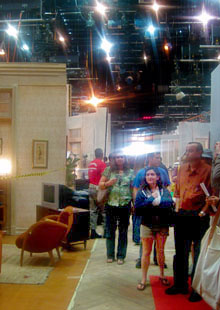Students Take Pulse of Brazilian Culture
When our group of Tulane students reached South America for the Summer in Brazil study program, the first lesson had to do with weather. New Orleanians are sweltering in heat and humidity in June but it's actually winter in Brazil. With 70-degree temperatures in Rio de Janeiro, no one could complain. We were all ready to observe and study Brazilian culture, history and society for the three-week program.

Tulane students studying in Brazil this summer tour Globo Studios in Rio de Janeiro, one of the world's largest production companies. (Photo by Tricia Travis)
Twenty students led by two members of the Tulane faculty, Ana Lopez and Vicki Mayer, ventured to South America for the program, sponsored by the the Stone Center for Latin American Studies. The studies would include a particular emphasis on media and communication as we earned six credits in two courses.
Our group touched down in Rio de Janeiro after an 11-hour flight on May 30 from different parts of the country and then traveled four hours to Paraty, Brazil. Exploring the small historic town, we acclimated ourselves to Brazilian culture.
We ate at the kilo restaurants, where you pay per kilogram of food, shopped for Havaianas flip-flops, and walked around the cobblestone roads in the historic center of Paraty. We got the chance to take a magical boat ride out of Paraty into the Atlantic Ocean on a perfect, sunny day.
There also was serious work to do on this three-week trip. We had class from 9 a.m. until 1 p.m. almost every day. Lopez, associate professor of communication, associate provost for faculty affairs and director of the Cuban and Caribbean Studies Institute at Tulane, conducted a course in "Brazilian Culture and Society," while Mayer, associate professor and chair of communication, taught an intercultural analysis class.
Lopez instructed us on the history of Brazil and many aspects of Brazilian culture and society. We learned about soccer ("futebol" in Brazil), samba, Carnival, Brazilian film and art, the favelas (slums) and much more. In Mayer's course we explored methods of communication within and among cultures.
We were able to practice our intercultural communication skills hands-on through assignments such as the "saudade" interview project, where we recorded locals explaining what this word meant to them. We came to understand that it is a word unique to Brazilian culture that signifies a deep longing for someone or something that is close to one's heart, and is not present in one's life at that moment.
In the next phase of the program, we traveled to bustling Rio de Janeiro and settled into our hotel across from the beach in the famous Copacabana neighborhood. We took a trip to the world's largest soccer stadium, Maracana Stadium, to watch two teams battle in Brazil's favorite sport. We also took a tour of Globo Studios, where we were able to step inside television sets of the popular telenovela series.
In Rio, we explored the favelas slums that have become distinctive social microcosms. This tour was an eye-opener and a crucial part of our education about the culture and society of Brazil.
The trip made for an unforgettable experience and one that will surely bring many of the students back to South America in the near future.
Tricia Travis is a rising junior majoring in communication at Tulane University.
